Related Research Articles

Mining is the extraction of valuable geological materials and minerals from the surface of the Earth. Mining is required to obtain most materials that cannot be grown through agricultural processes, or feasibly created artificially in a laboratory or factory. Ores recovered by mining include metals, coal, oil shale, gemstones, limestone, chalk, dimension stone, rock salt, potash, gravel, and clay. The ore must be a rock or mineral that contains valuable constituent, can be extracted or mined and sold for profit. Mining in a wider sense includes extraction of any non-renewable resource such as petroleum, natural gas, or even water.

The General Mining Act of 1872 is a United States federal law that authorizes and governs prospecting and mining for economic minerals, such as gold, platinum, and silver, on federal public lands. This law, approved on May 10, 1872, codified the informal system of acquiring and protecting mining claims on public land, formed by prospectors in California and Nevada from the late 1840s through the 1860s, such as during the California Gold Rush. All citizens of the United States of America 18 years or older have the right under the 1872 mining law to locate a lode or placer (gravel) mining claim on federal lands open to mineral entry. These claims may be located once a discovery of a locatable mineral is made. Locatable minerals include but are not limited to platinum, gold, silver, copper, lead, zinc, uranium and tungsten.

The California State Mining and Mineral Museum exhibits and interprets the state's mineral resources and mining heritage. It is part of the California state park system and is located in Mariposa, a city in central California, on the Mariposa County fairgrounds.

North Stradbroke Island, colloquially Straddie or North Straddie, is an island that lies within Moreton Bay in the Australian state of Queensland, 30 kilometres (19 mi) southeast of the centre of Brisbane. Originally there was only one Stradbroke Island but in 1896 it split into North Stradbroke Island and South Stradbroke Island separated by the Jumpinpin Channel. The Quandamooka people are the traditional owners of North Stradbroke island.
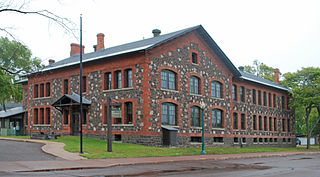
Keweenaw National Historical Park is a unit of the U.S. National Park Service. Established in 1992, the park celebrates the life and history of the Keweenaw Peninsula in the Upper Peninsula of the U.S. state of Michigan. It is a federal-local cooperative park made up of two primary units, the Calumet Unit and the Quincy Unit, and almost two dozen cooperating "Heritage Sites" located on federal, state, and privately owned land in and around the Keweenaw Peninsula. The National Park Service owns approximately 1,700 acres (690 ha) in the Calumet and Quincy Units. Units are located in Baraga, Houghton, Keweenaw, and Ontonagon counties.
Hudbay Minerals Inc. is a diversified Canadian mining company primarily producing copper concentrate and zinc metal. Much of its history has centered on Flin Flon, Manitoba, where it has mined for over 90 years. Hudbay currently has operations in Manitoba and Peru, and is working towards building a copper mine in southern Arizona. The company also has exploration properties in Canada, Peru, Chile and the United States.
The Illinois Department of Natural Resources (IDNR) is the code department of the Illinois state government that operates the state parks and state recreation areas, enforces the fishing and game laws of Illinois, regulates Illinois coal mines, operates the Illinois State Museum system, and oversees scientific research into the soil, water, and mineral resources of the state. In 2017, the Illinois Historic Preservation Division was added to its portfolio. It is headquartered in the state capital of Springfield.
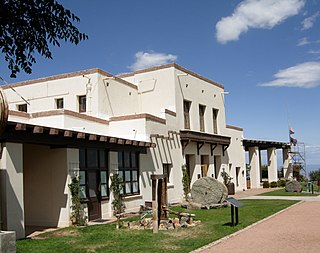
Jerome State Historic Park is a state park of Arizona, US, featuring the Douglas Mansion, built in 1916 by a family of influential mining entrepreneurs in Jerome, Arizona, a mining region in the northeast of the Black Hills, east Yavapai County. A museum is located in the old Douglas Mansion.
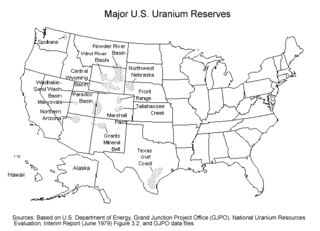
Uranium mining in the United States produced 224,331 pounds (101.8 tonnes) of U3O8 in 2023, 15% of the 2018 production of 1,447,945 pounds (656.8 tonnes) of U3O8. The 2023 production represents 0.4% of the uranium fuel requirements of the US's nuclear power reactors for the year. Production came from five in-situ leaching plants, four in Wyoming (Nichols Ranch ISR Project, Lance Project, Lost Creek Project, and Smith Ranch-Highland Operation) and one in Nebraska (Crowe Butte Operation); and from the White Mesa conventional mill in Utah.
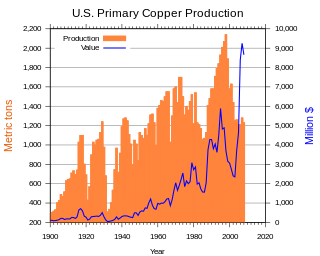
In the United States, copper mining has been a major industry since the rise of the northern Michigan copper district in the 1840s. In 2017, the US produced 1.27 million metric tonnes of copper, worth $8 billion, making it the world's fourth largest copper producer, after Chile, China, and Peru. Copper was produced from 23 mines in the US. Top copper producing states in 2014 were Arizona, Utah, New Mexico, Nevada, and Montana. Minor production also came from Idaho and Missouri. As of 2014, the US had 45 million tonnes of known remaining reserves of copper, the fifth largest known copper reserves in the world, after Chile, Australia, Peru, and Mexico.
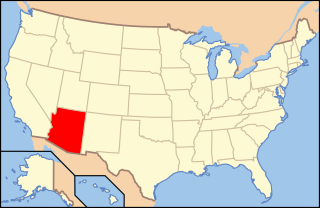
In Arizona, copper mining has been a major industry since the 19th century. In 2007, Arizona was the leading copper-producing state in the country, producing 750 thousand metric tons of copper, valued at $5.54 billion. Arizona's copper production was 60% of the total for the United States. Copper mining also produces gold and silver as byproducts. Byproduct molybdenum from copper mining makes Arizona the nation's second-largest producer of that metal. Although copper mineralization was found by the earliest Spanish explorers of Arizona, the territory was remote, and copper could seldom be profitably mined and shipped. Early Spanish, Mexican, and American prospectors searched for gold and silver, and ignored copper. It was not until the completion of the Southern Pacific Railroad in 1876 that copper became broadly economic to mine and ship to market.

The mineral industry is one of the main sectors of the Armenian economy and in 2017 accounted for 30.1% of its exports.
The Coolgardie Gold Mine is a gold mine located at Coolgardie, Western Australia, currently owned by Focus Minerals Limited. The mine and its Three Mile Hill Processing Plant has been in care and maintenance since June 2013.
The Higginsville Gold Mine is a gold mine located near Higginsville, 45 km north of Norseman, Western Australia.
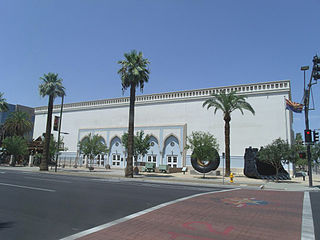
The Polly Rosenbaum Building, formerly the El Zaribah Shrine Auditorium, is a building in Phoenix, Arizona, at the corner of 15th Avenue and Washington Street, that was built in 1921. The 18,000-square-foot (1,700 m2) building formerly housed the Arizona Mining and Mineral Museum.
The Department of Mines and Petroleum was a department of the Government of Western Australia until it was superseded by the Department of Mines, Industry Regulation and Safety on 1 July 2017. The department was formed on 1 January 2009, out of the former Department of Industry and Resources and Department of Consumer and Employment Protection, which were split into three new departments, the Department of Mines and Petroleum, the Department of State Development and the Department of Commerce.
The Arizona Mining and Mineral Museum in Phoenix, Arizona, was a museum focused on minerals and mining. Last operated by the Arizona Historical Society, a state government agency, its exhibits included more than 3,000 minerals, rocks, fossils, and artifacts related to the mining industry. The museum closed in May 2011. In April 2017, legislation was passed to reopen the museum under the ownership of the University of Arizona.

Iron ore mining in Western Australia, in the 2018–19 financial year, accounted for 54 percent of the total value of the state's resource production, with a value of A$78.2 billion. The overall value of the minerals and petroleum industry in Western Australia was A$145 billion in 2018–19, a 26 percent increase on the previous financial year.
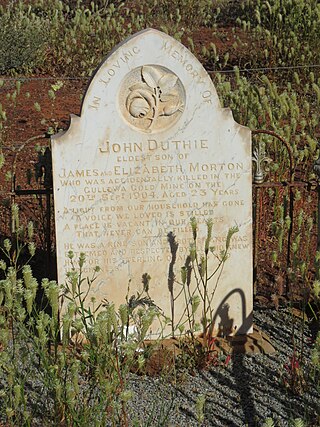
Fatality statistics in the Western Australian mining industry captures the number of people killed in the industry in the Australian state of Western Australia. During the period 2000-2012 (inclusive), a total of 52 fatalities occurred. In 2006, the Chamber of Minerals and Energy of Western Australia commissioned a taxonomic study to analyse the 306 mining fatalities which occurred between 1970 and 2006. The Department of Mines and Petroleum, later renamed the Department of Mines, Industry Regulation and Safety, the governing authority for the industry in the state, has published statistics for fatalities in mining dating back to 1943 and intends to publish statistics dating back to 1886, though early records are not expected to be exhaustive.
Rosemont Copper is a proposed large open pit copper mine project by the Canadian mining corporation Hudbay Minerals. The project site is located within the Santa Rita Mountains and Coronado National Forest, in Pima County of southern Arizona. It has undergone a permitting review process under the direction of the United States Forest Service and the U.S. Army Corps of Engineers and has been delayed by legal judgements and suspension of its operating permit by the US Army Corps of Engineers.
References
- 1 2 Bobby J. Bonner, Mining in Arizona Archived June 18, 2011, at the Wayback Machine , Becoming Arizona website, December 8, 2009
- ↑ Changes in the Department of Mines and Mineral Resources, Arizona Department of Mines and Mineral Resources, July 29, 2010
- ↑ About DMMR Archived July 22, 2011, at the Wayback Machine , Arizona Department of Mines and Mineral Resources website
- ↑ Mineral Management Program Archived October 26, 2010, at the Wayback Machine , Arizona State Land Department website
- ↑ "Arizona Cultural Inventory Project". Archived from the original on 2010-07-16. Retrieved 2010-11-09.